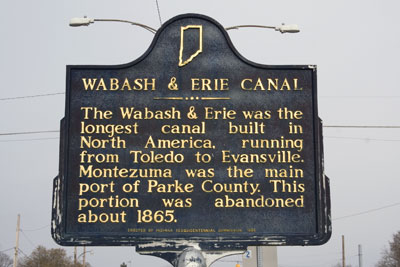Wabash and Erie Canal
 On March 2, 1827, Congress provided a land grant to encourage Indiana to build the Wabash & Erie Canal. The original plan was to link the navigable water of the Maumee with the Wabash through the seven mile portage at Fort Wayne. Work began five years later on February 22, 1832, in Fort Wayne. Construction proceeded west as the canal reached Huntington by 1835, Logansport in 1838, and Lafayette in 1841. Work was also performed east toward Ohio, but the canal did not open to Toledo until 1843. A second federal land grant enabled the canal to reach Terre Haute by 1849.
On March 2, 1827, Congress provided a land grant to encourage Indiana to build the Wabash & Erie Canal. The original plan was to link the navigable water of the Maumee with the Wabash through the seven mile portage at Fort Wayne. Work began five years later on February 22, 1832, in Fort Wayne. Construction proceeded west as the canal reached Huntington by 1835, Logansport in 1838, and Lafayette in 1841. Work was also performed east toward Ohio, but the canal did not open to Toledo until 1843. A second federal land grant enabled the canal to reach Terre Haute by 1849.
At Evansville, 20 miles of the Central Canal had been completed north by 1839. The Wabash & Erie Canal was extended south in the late 1840’s through the abandoned Cross-Cut Canal works to Worthington and then south following the old proposed Central Canal route. The connection with the Evansville segment was completed in 1853, forming the longest canal in the United States. By 1860, portions south of Terre Haute were closed and the process of decline continued northward. In 1876, the canal was auctioned off by the trustees; only 140 miles of the canal are still in use today.
The 468 mile long Wabash and Erie Canal, built between February 22, 1832 (George Washington’s Birthday) and 1853, was the longest canal ever built in the Western Hemisphere. It is surpassed only by the Grand Canal in China, which was 1,200 miles long.
The intentions were to connect the Erie Canal with the Ohio River and to expand commerce to the west, thereby increasing trade, import and export of goods, and transportation.
Native timbers and sandstone were used to build the canal until after the turn of the century, when concrete was used. No pumps were used to move the water — it was moved entirely by gravity.
The canal was 40 feet wide at the berm, 26 feet wide at the bottom, and 4 feet deep. The berm was 6’ wide. The towpath was 10’ wide and was used to pull the boats with mules and horses at a speed of 3-5 mph. Mules were usually used, as they were stronger animals. The ropes used to pull the boats by the mules were 3” in diameter and 100’-150’ long.
The canal was usually built near a waterway, but sometimes it cut across dry land. Building a half mile section of canal could cost between $500 to $2000. A lock cost anywhere between $5000 to $8000, based on the costs of the cross-cut between Terre Haute and Point Commerce in Worthington. Canal engineers had to make trade-offs between longer sections or more locks. The costs depended on obstacles in the path of construction as to whether the canal prism had to be built above ground level, at ground level, or were cut deep below ground level. In the case of a lock, cost depended on the lock’s lift, the availability of materials, and the type of lock: cut stone, rough stone lined with wood, or timber frame/timber crib.
